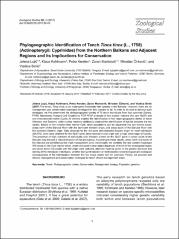| dc.description.abstract | The tench, Tinca tinca, is an endangered freshwater fish species in the Balkans. However, there are no
management and conservation strategies developed for this species so far. In order to be able to develop such
strategies, we first determined the phylogeographic identity of 70 tench individuals from four countries (Serbia,
FYRO Macedonia, Hungary and Croatia) by PCR-RFLP analyses of two nuclear markers (Act and RpS7) and
one mitochondrial marker (Cytb). All makers enabled the identification of two major geographic clades of tench
(Western and Eastern), while nuclear markers additionally enabled the identification of hybrids between the two
clades. Based on the mitochondrial marker Cytb, tench populations can be separated into two distinct areas:
areas north of the Danube River with the dominant Western origin, and areas south of the Danube River with
the dominant Eastern origin. Data obtained for the Act gene demonstrated Eastern origin for most individuals
(88.23%) while data obtained for the RpS7 gene demonstrated mixed origin with a high percentage of hybrids.
The presence of high numbers of individuals with Western alleles for the RpS7 gene in areas south of the
Danube may indicate a natural invasion of this phylogroup. According to these results, areas north and south of
the Danube are identified as two main management units. Additionally, we identified the rare western haplotype
W2 based on the Cytb marker which clearly indicated human-aided dispersals of tench in the investigated region
and since some individuals with W2 origin were cultured, attention must be given to the genetic structure and
identity of the introduced individuals, whether during introduction or reintroduction since biological and ecological
consequences of the hybridization between the two major clades are still unknown. Finally, we propose and
discuss management and conservation strategies for tench of both management areas. | en_US |

